
Assam is a state in northeastern India, south of the eastern Himalayas along the Brahmaputra and Barak River valleys. Assam covers an area of 78,438 km2 (30,285 sq mi). The state is bordered by Bhutan and Arunachal Pradesh to the north; Nagaland and Manipur to the east; Meghalaya, Tripura, Mizoram and Bangladesh to the south; and West Bengal to the west via the Siliguri Corridor, a 22 kilometres (14 mi) wide strip of land that connects the state to the rest of India. Assamese and Boro are the official languages of Assam, while Bengali is an additional official language in the Barak Valley.
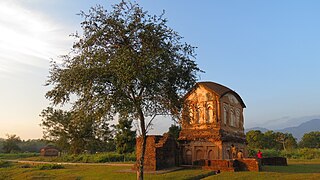
Cachardistrict is an administrative district in the state of Assam in India. After independence, the undivided Cachar district was split into four districts in Assam: Dima Hasao district, and Cachar district alongside Hailakandi and Karimganj.

Karimganj district is one of the 34 districts of the Indian state of Assam. Karimganj town is both the administrative headquarters district and the biggest town of this district. It is located in southern Assam and borders Tripura and the Sylhet Division of Bangladesh. It makes up the Barak Valley alongside Hailakandi and Cachar. Karimganj was previously part of the Sylhet District before the Partition of India. It became a district in 1983.

Morigaon district is an administrative district in the state of Assam in India. The district headquarters is located at Morigaon. The ancient place of occult Mayong is located in this district as well as Pobitora Wildlife Sanctuary.

Silchar is a city and the headquarters of the Cachar district of the state of Assam, India. It is 2nd largest city of North Eastern Region after Guwahati in terms of area, population and GDP. It is also administrative capital of Barak Valley division. It is located 343 kilometres south east of Guwahati. It was founded by Captain Thomas Fisher in 1832 when he shifted the headquarters of Cachar to Janiganj in Silchar. It earned the moniker "Island of Peace" from Indira Gandhi, the then Prime Minister of India. Silchar is the site of the world's first polo club and the first competitive polo match. In 1985, an Air India flight from Kolkata to Silchar became the world's first all-women crew flight. Silchar was a tea town and Cachar club was the meeting point for tea planters.
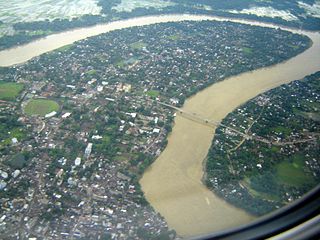
The Barak River flows 900 kilometres (560 mi) through the states of Manipur, Nagaland, Mizoram and Assam in India. Further it enters Bangladesh where it bifurcates into the Surma river and the Kushiyara river which converges again to become the Meghna river before forming the Ganges Delta with the Ganga and the Brahmaputra rivers and flowing into the Bay of Bengal. Of its length 524 km (326 mi) is in India, 31 km (19 mi) on the Indo–Bangladesh border and the rest is in Bangladesh. The upper part of its navigable part is in India — 121 km (75 mi) between Lakhipur and Bhanga, declared as National Waterway 6, (NW-6) since the year 2016. It drains a basin of 52,000 km2 (20,000 sq mi), of which 41,723 km2 (16,109 sq mi) lies in India, 1.38% (rounded) of the country. The water and banks host or are visited by a wide variety of flora and fauna.
Tipaimukh is located in south-western hilly region of Manipur bordering the Indian state of Mizoram. It is one of the six tribal development blocks of Churachandpur district in Manipur state. Parbung is the sub-divisional block headquarters. Tipaimukh is the 55th Assembly Constituency of Manipur. The present sitting Member of Legislative Assembly (MLA) is Chaltawnlien Amo. The total geographic area of the sub-division block is 789.48 km², having 55 villages with the total population of 23,995 approx. The total number of voters is 18,848. The total distance from the Parbung to the district headquarters town of Churachandpur is 247 km through the Tipaimukh Road, also known as NH 150.
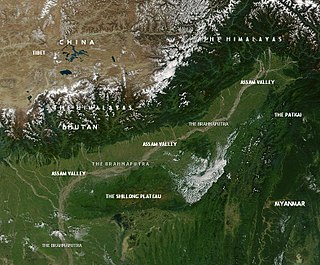
This article discusses the geological origin, geomorphic characteristics, and climate of the northeastern Indian state of Assam. Extending from 89° 42′ E to 96° E longitude and 24° 8′ N to 28° 2′ N latitude, it has an area of 78,438 km2, similar to that of Ireland or Austria.

The Barak Valley is in the southern region of the Indian state of Assam. The region is named after the Barak river. The Barak valley consists of three administrative districts of Assam - namely Cachar, Karimganj, and Hailakandi. The main, largest and capital city of the Valley is Silchar. Once North Cachar Hills was a part of the valley but In 1951 erstwhile Sub-Division was made a separate district and eventually curved out of Cachar. On 1 July 1983, Karimganj district was curved out from the eponymous subdivision of Cachar Valley. This was again repeated in 1989 with the creation of Hailakandi district.
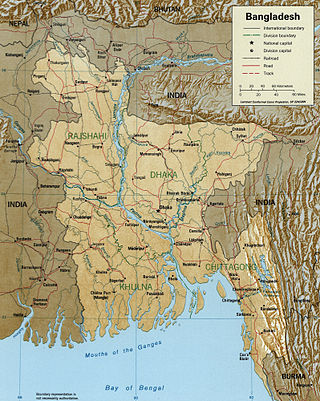
The Surma-Meghna River System is a river complex in the Indian Subcontinent, one of the three that form the Ganges Delta, the largest on earth. It rises in the Manipur Hills of northeast India as the Barak River and flows west becoming the Surma River and then flows south as the Meghna River, a total of 946 kilometres (588 mi) of which 669 kilometres (416 mi) are within Bangladesh, to the Bay of Bengal.
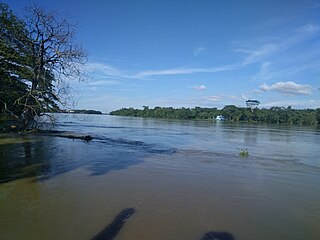
The Kushiyara River is a transboundary river in Bangladesh and Assam, India. It forms on the India-Bangladesh border as a branch of the Barak River, when the Barak separates into the Kushiyara and Surma. The waters that eventually form the Kushiyara originate in the uplands of the state of Assam and pick up tributaries from Nagaland and Manipur.
Ranglong is an ethic people belonging to the old kuki chin, majority of Ranglong's live in the northeastern part of India, mainly in the border area's of Tripura, Assam and Mizoram. The Ranglong people live in a small and densely-packed area over three federal Indian states,(tripura, Assam and Mizoram)
Assam – 16th largest, 15th most populous and 26th most literate state of the 28 states of the democratic Republic of India. Assam is at 14th position in life expectancy and 8th in female-to-male sex ratio. Assam is the 21st most media exposed states in India. The Economy of Assam is largely agriculture based with 69% of the population engaged in it. Growth rate of Assam's income has not kept pace with that of India's during the Post-British Era; differences increased rapidly since the 1970s. While the Indian economy grew at 6 percent per annum over the period of 1981 to 2000, the same of Assam's grew only by 3.3 percent.
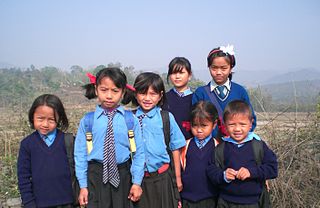
The hill tribes of Northeast India are hill people, mostly classified as Scheduled Tribes (STs), who live in the Northeast India region. This region has the largest proportion of scheduled tribes in the country.

The Jatinga River is a north bank tributary of the Barak River in the Indian state of Assam. The river originates from Barail hill range in the village Jatinga at Dima Hasao district of Assam. The Jatinga then flows through the western boundary of the Barail Wildlife Sanctuary and then join several other small tributaries like Chhotarekha, Bororekha, Daku, Chhota Lokha, Dimru, Ditokcherra, Kayang, Dolu, Badri etc before its confluence with the Barak river at Jatingamukh below Barkhola village near Chandpur of Cachar District.
The Gabharu River is a northern bank tributary of the Brahmaputra River in the Indian state of Assam. The Gabharu river originates in the Kalafangapo hills of Arunachal Pradesh in the West Kameng District and flows through Sonitpur district of Assam before its confluence with the Brahmaputra river at Gadharu Mukh of Sonitpur district. The Gabharu river consists of two right bank subtributaries known as Sonairupai river and Gelgeli river and Mora Depota river is the left bank sub tributary.
The Jhanji River is a tributary of the Brahmaputra River in the Indian state of Assam. The Jhanji river originates in Mokokchung district of Nagaland.

Bengali Hindus are the second largest Hindu community in Assam just after Assamese speaking Hindus. As per as estimation, around 6–7.5 million Bengali Hindus live in Assam as of 2011, majority of whom live in Barak Valley and a significant population resides in Assam's mainland Brahmaputra valley. Most Bengalis in Assamese dominated Brahmaputra valley are immigrants from neighbouring Bengal region and Tripura, while Bengalis in Barak Valley region of Assam are mostly native.
Beginning in May 2022, deadly floods hit northeastern India and Bangladesh. Over 9 million people in both countries have been affected, and around 300 people have been killed.














